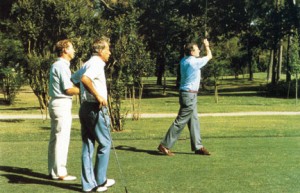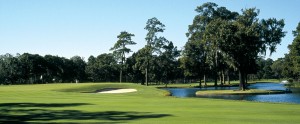 As you drive down River Oaks Boulevard toward the resplendent clubhouse that sits just in the distance, it takes a sizeable measure of thought to imagine the surroundings as they were some 83 years ago here in Houston. What was at that time a densely-wooded place for dairy cattle and tree-farming would become the home of one of the finest clubs in the nation.
As you drive down River Oaks Boulevard toward the resplendent clubhouse that sits just in the distance, it takes a sizeable measure of thought to imagine the surroundings as they were some 83 years ago here in Houston. What was at that time a densely-wooded place for dairy cattle and tree-farming would become the home of one of the finest clubs in the nation.
On February 1, 1923, Lynch Davidson, K.E. Womack and Henry H. Dickson signed the incorporation papers to create the River Oaks Country Club. This act followed an initially dismissed idea put forth by T.W. House, Jr., then-owner of the property on which the club sits, to create an outstanding subdivision of homes and a golf course.
Despite those who doubted the viability of such a club in an area that was then considered quite far from downtown Houston, House enlisted the help of Congressman Thomas H. Ball. Together with several others, House and Ball began selling memberships in the club. Within eight months, 300 memberships were sold and Ball had enlisted one of world’s greatest architects to design the club’s golf course. At the same time, Will Hogg and Hugh Potter – two of the many who initially dismissed the idea – began purchasing additional land under the River Oaks Corporation to create what remains today as one of the finest and most exquisite places to reside in all of Houston. 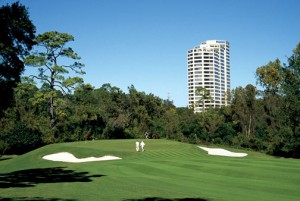
Yet, for anything of quality to stand the test of time, it must have at its root a great heart and soul to anchor the great idea that spawned it. For River Oaks, it began with the inclusion of three very important people charged with shaping the experience of River Oaks. Donald Ross, the greatest golf course architect of his time and a legend still today, created the original 18 holes of River Oaks. The club represents one of only three courses that the great Ross ever designed in Texas.
There was a redesign in 1968-70 by Joe Finger, substantial losses of trees to Hurricane Alicia in 1983 followed by a terrible freeze that winter and another redesign in 1998 by the esteemed Rees Jones. But, although many of the holes may have changed significantly since its creation, the course still exemplifies the spirit of Ross. John Staub, one of America’s foremost residential architects, designed the original two-story Spanish Colonial clubhouse. Although it was replaced by the current clubhouse in 1969, which has since grown to 114,000 square feet, Staub’s original design remained present and in tact in many ways until the time of its replacement.
Jack Burke, Sr. was River Oaks’ first golf professional. An accomplished golfer, Burke won the Texas PGA Open Championship six times and later won the PGA Seniors Championship in 1941. Burke devoted most of his 19 years at River Oaks to teaching, with a particular emphasis on the modern swing techniques practiced by Bobby Jones. Many of the game’s legends have become part of the history of River Oaks over the years, including Bobby Jones (granted an honorary membership in 1927), Babe Didrickson, Jimmy Demaret (the club’s second golf professional), Dave Marr, Homero Blanco, Scott Verplank and the great trio of Nelson, Hogan and Snead.
The latter trio finished first, second and third in the inaugural Tournament of Champions in 1946 at River Oaks, the only time in their storied careers that the trio finished 1-2-3 in competition. Sixty years later, this grand event is now known as the Shell Houston Open. Demaret represents one of River Oaks’ greatest traditions, that of embracing youth and participating in their growth throughout their lives.
Demaret started working at River Oaks as a 9-year-old caddy. He grew to working in the pro shop and then developed his own legendary game under the support and guidance of Burke before returning in 1943 following Burke’s death. He served as River Oaks’ golf professional for three years before leaving for military service and a legendary career as one of the creators of the modern PGA Tour. This commitment to participating in the lives of the River Oaks family has repeated itself many, many times; most recently in the life of the current golf professional, Bruce Davidson, who began working at River Oaks as a caddy himself.
In fact, Davidson – originally from Scotland – received a scholarship to the University of St. Thomas in Houston through the assistance of Jackie Burke in the late 1970s. While at St. Thomas, Davidson competed against Dick Harmon (son of Claude Harmon; Claude served as River Oaks’ golf professional from 1943-44 and won the 1948 Masters). Dick later gave Davidson his first caddying job at River Oaks and had a substantial impact on Davidson’s life. “
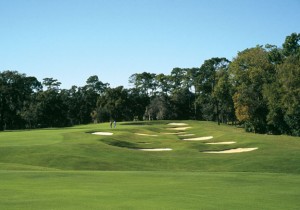 I got more of an education here than I did at the university,” Davidson recently said. “To be able to interact with the quality membership that we have here and to work with Dick Harmon” have been two of the greatest highlights of Davidson’s life. “This is a great job,” Davidson said. “Dick made it a great job.”
I got more of an education here than I did at the university,” Davidson recently said. “To be able to interact with the quality membership that we have here and to work with Dick Harmon” have been two of the greatest highlights of Davidson’s life. “This is a great job,” Davidson said. “Dick made it a great job.”
Dick Harmon served as golf professional from 1977-2001, the longest tenure of any River Oaks golf professional. His impact on the club has been the greatest of anyone in his position. From his renowned teaching of the game to his ability to have touring professionals visit the club and participate in clinics, there are not enough words to express the footprint that Harmon left at River Oaks. One of the most wonderful legacies is that of the Grampian Houston Foundation.
Davidson spearheaded the creation of the foundation with the active involvement and support of Harmon. Through a partnership with Royal Aberdeen Golf Club in Scotland, the sixth oldest golf club in the world, the foundation brings a number of junior golfers from Scotland every two years with the hope of securing college scholarships for them in the United States.
To date, 100 students have traveled to Houston, with 25 receiving university scholarships. In addition to Davidson and Harmon at River Oaks, Gordon Johnson at Houston Country Club and Ken MacDonald at BraeBurn Country Club have supported the program for years. With the support of River Oaks members and members of the other clubs, more than $500,000 has been raised in the last 10 years to support the foundation.
Of course, when River Oaks was originally created, the corporate documents included tennis as one of its operational purposes. As with golf, River Oaks has led the way as one of the most important tennis clubs in the United States. From its inception in 1931, the River Oaks International now stands as the oldest event in the United States still played at its original site and on its original surface (clay), second in the world only to Wimbledon.
The list of tennis greats that have played at River Oaks before they became known worldwide is monumental: Bjorn Borg, Ivan Lendl, Boris Becker, Andre Agassi, Michael Chang, James Blake, Roger Federer. Past winners include Bobby Riggs, Rod Laver (four times), John Newcombe, Lendl (three times) and finals appearances by the likes of Borg, Vitas Gerulaitis, Mats Wilander and Federer. Still, golf and tennis aside, the heart and soul of River Oaks lies in its membership and its staff: the “family” that is River Oaks. Joe Bendy, Jr., general manager of River Oaks, believes that the future of the club lies in its ability to assist in the development of the children of its members.
“A church and a club are both one generation from dying at any time,” Bendy said. “Our club, as an entity, must continue to invest in its future. We have to ask, ‘What can we do to help the children succeed in life?’” That philosophy is what has led to the major expansion that has occurred over the last few years at River Oaks. With 1,600 members participating in what is essentially a land-locked area, the ability to service all of the needs and desires can be daunting.
Yet, Bendy sees that challenge as a source of inspiration. “Constant, never-ending improvement is the focus of what makes any business, club or venture successful,” he said.
“I’m even more excited today than when I first walked through the door.”
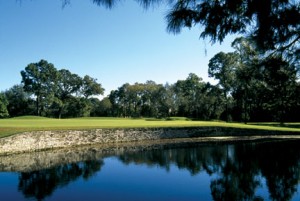 One inspiring aspect of the River Oaks philosophy is to embrace the staff of the club as family members. In fact, an entire chapter of A Chronicle of River Oaks Country Club, the written history of the club, is devoted to notable staff members who invested their own lives in the development of the club. That appreciation is something that River Oaks has shown since its inception and is woven into its culture.
One inspiring aspect of the River Oaks philosophy is to embrace the staff of the club as family members. In fact, an entire chapter of A Chronicle of River Oaks Country Club, the written history of the club, is devoted to notable staff members who invested their own lives in the development of the club. That appreciation is something that River Oaks has shown since its inception and is woven into its culture.
“It’s a culture of concern, a culture of caring and a culture of family,” Bender said.
A recent example of the across-the-board familial nature of the club occurred following Tropical Storm Allison in 2001. Many of the club’s staff members were either flooded out of their homes or sustained major damages to their homes and belongings. The club’s members initiated an internal drive to raise funds and to donate clothes, furniture, food and other items for the staff and their families. Similar donations have been made if staff members become ill or suffer medical emergencies.
Eighty-three years since a small group of men envisioned something that others were unable to see, River Oaks Country Club continues to excel and have an impact on all who take part in its existence. Yet, though clubs at times can grow stagnant and find themselves frozen in time, River Oaks takes pride in never settling for that which has come before the present and in always embracing the changes of life.
“The needs of the membership continue to evolve and we try to evolve with our members,” Bendy said. “It’s about being the best club that we can be for our members.”
By J.Frank Hernandez
